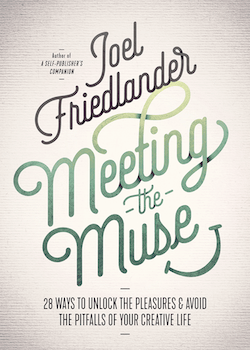I’m getting closer to publishing my new book on creativity called Meeting the Muse: 28 Ways to Unlock the Pleasures & Avoid the Pitfalls of Your Creative Life.
As regular readers know, this book is not about book publishing, it’s about the motives that move us to be creative, and the obstacles we often encounter.
My hope is in writing and publishing this book that I might save some younger artists and writers from some of the bad mindsets, wrong thinking, and blocked attempts at creativity that plague us all at times.
There are 28 separate short chapters in the book, each with a topic statement followed by a discussion of the theme from the topic. Each ends with a quote from someone you might recognize.
I’ve published on the blog the first of these sections, now I’d like to show you a different side.
There are 9 “Flex Your Creativity” exercises I created for the book, because putting these ideas into practice is what connects them with the real world, where we sit banging on our keyboards.
Here’s the list of Flex-Your-Creativity Exercises at the back of the book:
- Pay Attention
- Practice Freewriting
- Create a List of Lists
- Write a Haiku
- Take a Walk
- Establish a Daily Creative Practice
- Harness Your Moods
- Brainstorm with Mind Mapping
- Write a Letter to the Muse
Here’s an excerpt and Exercise number 2. It just could transform your writing life.
Flex-Your-Creativity Exercises
The best way I know to bring the ideas in this book to life is to put them in practice.
In this section, you’ll find exercises that can help you stimulate your own creativity. Some will appeal more than others, so follow your intuition to decide which to try first.
Throughout, remember that setting aside time to dive into the creative process often has an element of play, and I encourage you to enjoy this journey while you’re on it.
Practice Freewriting
More than any other creative practice, freewriting liberated me from many years of being creatively stuck.
What is freewriting?
It’s a deceptively simple practice that taps into our creative potential. It starts with a very short list of ingredients and is guided by a few simple ideas.
Why would you want to use it?
- Freewriting liberates your writer’s voice and connects you to the vibrant stream of creativity lying just under the surface of your ordinary thinking.
- Freewriting can be used to launch you right over a writer’s block, to explore painful emotional memories, or to work out problems in a longer piece. I use it primarily to contact my unconscious.
- Freewriting is a simple, structured practice, flexible and forgiving. It can be used as the base of a regular writing practice, spontaneously whenever you want to go deeper into a subject, or as a group exercise with your writing partners.
When we freewrite, we try as much as possible to suspend judgment about what we are writing. This makes freewriting an exercise in getting out of our own way. You may notice you are writing in a way you would usually find unacceptable or foreign.
You might find yourself expressing strong, alien, even violent stories or feelings. Don’t stop. Try to simply observe the process rather than interrupt it. Marvel at the fact that, like Walt Whitman, we each “contain multitudes,” many of whom we have yet to meet.
Here are my freewriting guidelines. However, in the spirit of freedom, feel free to not follow any that don’t feel right to you.
- Set a timer. Having a reliable timer will free you from being drawn away from what you are writing to check the time. If you’re in a good flow, you can continue writing after the time has expired until you complete your thought. For this exercise, set your timer for ten minutes. As soon as you hit the “Start” button, start writing and don’t stop writing until the timer ends.
- Use a prompt. If you run out of ideas before the time is up, start writing the prompt instead. Very soon a new thought will arise, and you can start writing again. The most reliable prompt I’ve found is from Natalie Goldberg, author of Writing Down the Bones, among other books. Her simple statement “I remember” has been the basis for countless freewrites and never disappoints. Many other prompts exist, of course, and you can use a photo or a piece of music or a painting as a prompt, too.
- Keep your pen moving. Again, don’t stop writing until the timer goes off.
- Write quickly. Write a little bit faster than you can form your thoughts, even if it’s uncomfortable. Messy handwriting is fine, words you can barely decipher are fine. Trust that what’s important for you to unearth will make itself known to you at
some point. - Use the first word. Don’t try to think of the perfect word, don’t cross out or erase the word you wrote, just use the first word that comes to mind and go with it. Don’t worry about paragraphing, subjectverb agreement, or even if what you are writing makes any sense at all. Don’t worry about who will be offended by what you’re writing or that it “doesn’t sound like you.” Just write.
- Write garbage. Give yourself permission to write a really bad first draft. You can always edit it later, but this permission allows you to do something new. Try to avoid any thoughts about what you are writing. You are just there to propel the pen—that’s your sole job. Telling yourself it’s okay to write terrible first drafts is incredibly liberating. Try it.
- Go for it. If the first thing that pops into your mind is ridiculous, go for it. If it’s violent, see where it goes. Be open to the unexpected. After all, you didn’t create these thoughts, did you? Our job is to honor them and allow them to come to light.

If you think this won’t work for you, please try it for a week. Pick a block of time you can set aside each day no matter what. You may need to get up earlier, watch a bit less television, shorten your lunch hour, or sit in your car while your child is in after-school activities.
How much time? Somewhere between ten minutes and two hours. Try ten minutes to get started. If possible, practice around the same time of day. Find a spot where you can be undisturbed, one that you can return to day after day as often as possible. This will set an intention within your mind and your body: this is your time to write.
For several years, I did this daily practice sitting in my car, writing in a journal or using an iPad with a keyboard. The key is to find what works for you.
Prepare to be amazed at what comes out of your pen and spills onto the page. You may be surprised, but remember, everything is coming from within you, and it will never stop.
I’ll be looking for reviewers in a couple of weeks, so if you’d like to get an advance copy of Meeting the Muse for review, let me know on my Contact Form.
Book cover designed by James Egan of Bookfly Design. Editing by Sharon Goldinger of PeopleSpeak.
Publication date is not set, but if you’re on my mailing list you’ll find out about it first, along with any “goodies” that accompany the launch.
Photo: bigstockphoto.com



